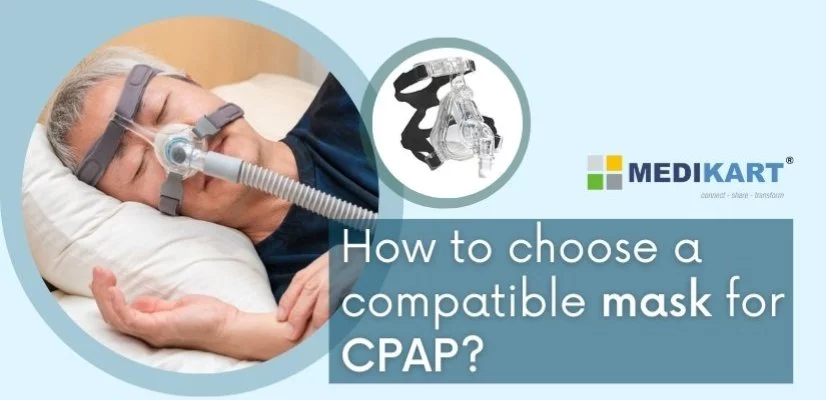Types of CPAP masks
CPAP Mask: A Comprehensive Guide
There are 3 different types of masks available in the market for people who are diagnosed with sleep apnea. There are three main types of CPAP masks, and they’re generally available in all sizes:
- Full Face masks – These masks cover both your nose and your mouth
- Nasal masks – These masks fit over your nose only, offering a lighter fit than full-face masks
- Nasal pillow masks – These masks are even more lightweight and minimal than nasal masks, offering a high level of openness and visibility.
Factors to consider while buying a CPA Mask
-
Size
It may seem evident based on these descriptions that you prefer a lighter mask over a heavier one, or a smaller mask over a larger one. There are, however, additional factors to consider. Masks that cover more of your face, for example, might sometimes provide a better seal against leaking, resulting in improved therapy. Similarly, if you have facial hair, you may require a larger mask to get a stronger seal. If you suffer from claustrophobia, a smaller mask is likely to be more comfortable.
Despite their somewhat higher weight, full-face masks may simply feel more comfortable — it all comes down to personal preference and how a given mask shape will fit over your face’s unique contours. In any event, your doctor can assist you in trying on a variety of masks to see which one is the greatest and most comfortable fit for you.
-
Material of cushion
Another factor that can help you choose your face mask is whether you prefer a silicone mask or a gel mask. Silicon masks are said to be thinner and more comfortable whereas Gel masks are said to prevent leaks effectively and be moderately comfortable. Eventually, it again boils down to personal preference and one can choose only after trying various masks out.
Your sleep position is also one of the factors to consider while choosing a CPAP mask. Since CPAP masks require a tight seal to avoid air leaks, sleeping in a way that presses on the mask is more than uncomfortable it can also compromise your treatment’s efficacy. A CPAP mask’s headgear can also interfere with sleep, particularly if they have hard plastic buckles or stiff anchor straps.
Sleeping on your side is one of the greatest postures for sleep apnea therapy because gravity does not affect your airway as much as it does when resting on your back or stomach, Unfortunately, finding the correct CPAP mask for side sleepers can be difficult.
Nasal pillow
Masks are a wonderful option for side sleepers who can handle them because their low profile rests higher than the pillow. Nasal masks, which cover the entire or a portion of the nose, are another alternative that many side sleepers find useful. Models with excellent seals, as well as soft and adjustable headgear, are the best.
CPAP users who sleep on their backs have a wide range of mask options, as this posture easily supports even full-face masks. While sleeping on your back may be the most comfortable position if you use a CPAP mask, gravity can induce airway collapse. If your doctor is aware that you sleep on your back and has not advised you to change positions, you will most likely be satisfied with any mask that is effective and meets your other demands. The position also makes it difficult to remove your mask, however single-strap headgear may be tough for certain back sleepers.
Stomach sleeping is the most uncommon sleeping position, and those who sleep on their stomachs have special considerations when selecting a CPAP mask. Most masks press onto the face in this position, producing pain and frequent air leaks. Depending on the size of your mask, it may pull your head into a posture that puts strain on your neck and causes pain or stiffness the next day.
Most people can only sleep on their stomach if they use a nasal pillow mask because of their low profile, nose pillows are great for this because they are unlikely to become dislodged or cause pain regardless of your sleeping position or pillow firmness.
-
Air Pressure Settings
Your air pressure setting has a stronger influence on mask choice than you might imagine. Any mask choice can work for people with rather low air pressure levels. Nasal pillows are a popular choice for people with low-pressure settings because their design minimizes air leakage.
However, at higher air pressure settings, this direct flow of air into the nostrils can be rather painful, even causing nasal dryness or nosebleeds. If you require a greater air pressure setting, a nasal mask or full face mask should be used instead. Breathing seems more natural at high settings because the airflow is more indirect.
These are some of the main factors one needs to consider while choosing a compatible CPAP mask. Other than this trying out different masks will help you in choosing the mask that’s right for you. I hope this article helped you in your sleep therapy journey!
Disclaimer
The information provided is for general knowledge only. Consult your doctor for personalized advice and treatment. Medikart HealthCare is not liable for any actions taken based on this info.

